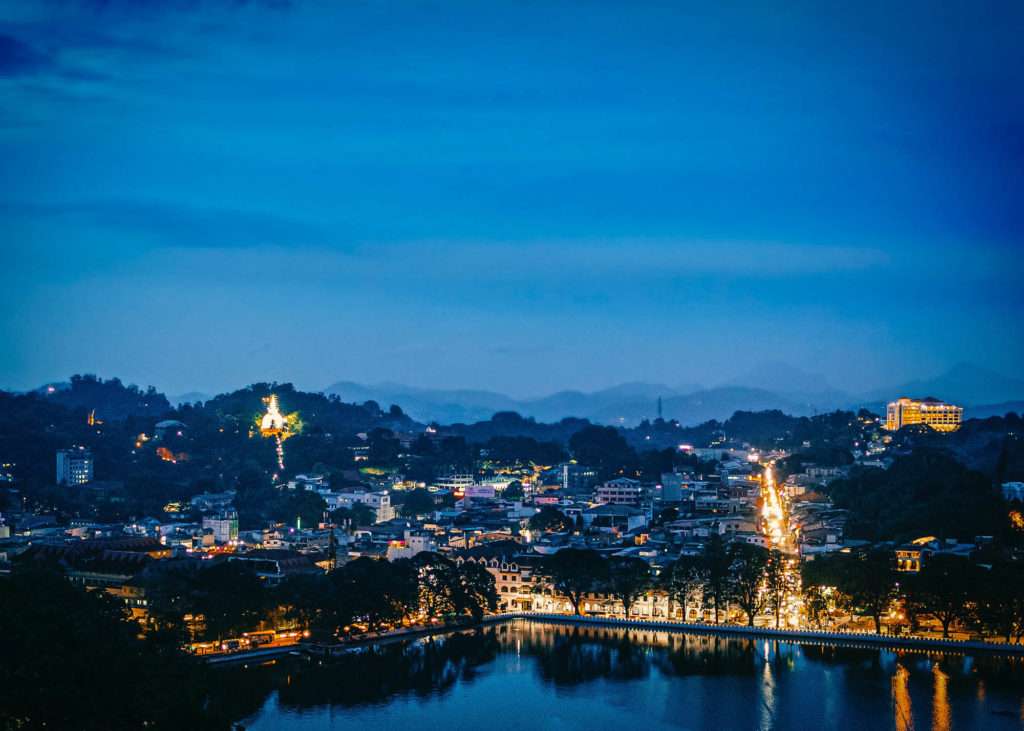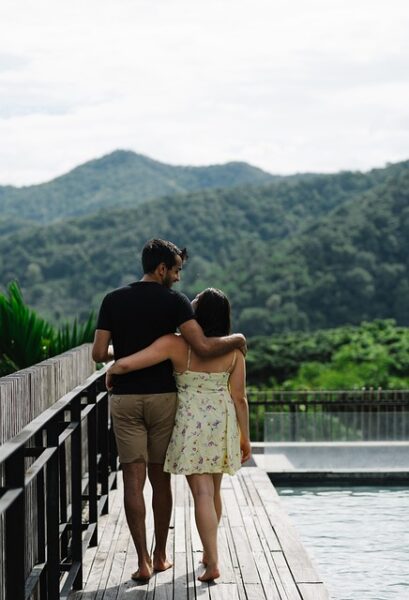History of the Buddhism in Sri Lanka
Before Prince Vijaya and his party were exiled from India to Sri Lanka in 543 BC, the island was inhabited by indigenous tribes. Prince Vijaya and his party is considerd as the forefathers of modern-day Sri Lanka. In the third century BC, Indian Emperor Asoka sent a party of Buddhist monks to Sri Lanka, along with Arahat Mahinda Thero, Emperor Asoka’s son. Many Indian traditions became ingrained in Sri Lankan culture thanks to the leadership of Arahat Mahinda Thero.
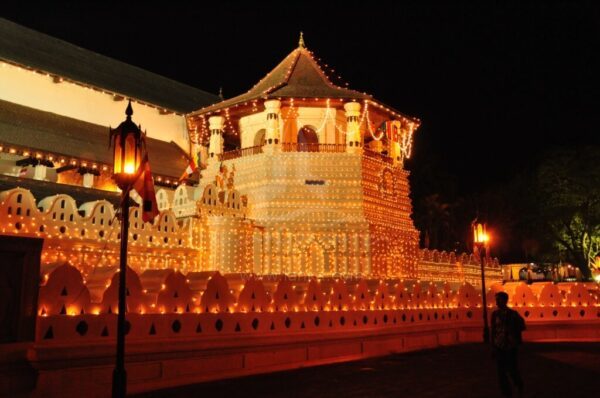
The arrival of the Sacred Tooth Relic of the Buddha
Buddha passed away when he was at age of 80 in Kushinagar, India. Thus, following the death (parinirvana), the Sacred Remains were passed down to eight Indian monarchs. The Monarchs constructed shrines and stupas to house the Sacred Relics. While venerated, the Sacred Tooth Relic was never enshrined.
The Sacred Tooth Relic was brought to Sri Lanka as a result of internal conflicts in Kalindgadesha, India (modern-day Orissa). Sri Moghavnna, the king of Sri Lanka at the time, was a devoted Buddhist who was willing to accept guardianship of the Sacred Relic. As a result, disguised as peasants, Prince Dantha and Princess Hemamali of India undertook the mission of smuggling the Sacred Tooth Relic to Sri Lanka.
The parade that greeted the Prince and Princes may not have been on equal with the modern-day Esala Perahera. However, according to historical archives, Sri Lankan Buddhists treated the Sacred Tooth Relic with respect. As it was moveable, the Sacred Tooth Relic quickly replaced the Sri Maha Bodhiya as the palladium of the kingship on the island. In times of conflict, when there were multiple claims to the Sri Lankan monarchy, whoever had guardianship of the Sacred Relic may be declared king.
Origin of the Kandy Perahera Festival
For a long time, it was strictly the property of the kings. That is, the general public was not permitted to worship the Sacred Relic. Throughout the rise and fall of numerous Sri Lankan kingdoms, the Sacred Tooth Relic remained albeit encased within guarded Temples.
Things changed once it arrived in Kandy for its final resting place. The public should be able to see and worship the Sacred Tooth Relic, according to King Keerthi Sri Rajasinghe (1747-1782 AD). As a result, the Kandy Esala Perahera was born. It has since become an annual event, with only a few cancellations.
Every Esala (July or August), Esala Perahera parade through the streets at night for ten days. Perahera literally means “parade of musicians, dancers, drummers, and other performers” in Sinhalese.
Before the Perahara commences, a series of religious rituals and ceremonies take place within the Temple of the Tooth Relic. These rituals, performed by Buddhist monks, invoke blessings and seek protection for the participants and attendees.
As part of the parade, well-dressed elephants and tuskers carry the tooth relic in a casket through the routes. The procession consists of a colorful and vibrant display of cultural performances and traditional customs. Hundreds of drummers, dancers, flag bearers, fire performers, and other participants take part in the procession. They wear ornate costumes and carry various symbolic items representing Sri Lankan traditions and religious beliefs. celebration concludes with a water cutting ritual at Kandy’s Mahaweli River.
In recent years, the Esala Perahera has gained international recognition and has become a major tourist attraction. It offers visitors a unique opportunity to experience Sri Lankan culture, traditions, and religious practices. The festival is a testament to the rich cultural diversity and the enduring spiritual beliefs of the country.
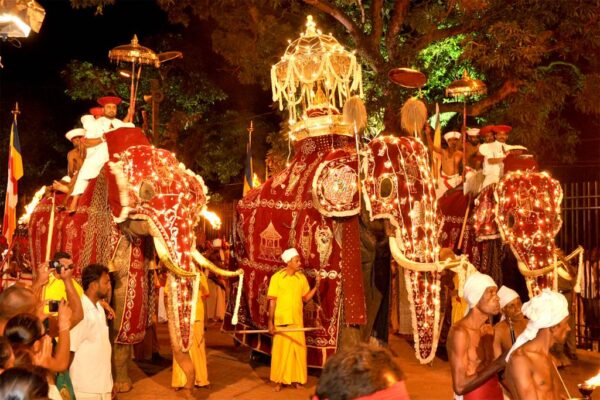
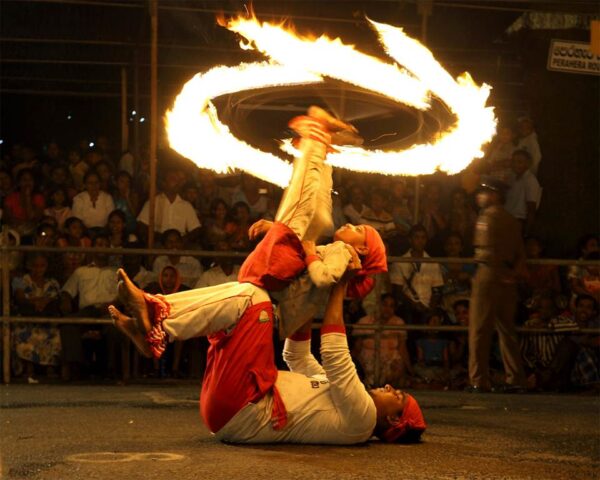
Tips For Attending Esala Perahera
- While there is no set dress requirement for the celebration, it is best to dress accordingly when participating in the parade.
- Book your hotel well in advance as most hotels near the center run out of rooms as the festival closes.
- Reach the destination ahead of schedule. Most parades begin between 8 and 9 p.m., so make sure you get a spot on the sidewalk before it begins.
- make sure to reserve a seat well in advance for a comfortable experience and a viewing gallery is what you’d admire the most to witness the Esala Perahera
- there are also guided tours available. If you are a history fan who does not want to miss out on any details, make a reservation for yourself.
Where To Stay During Kandy Perahera Festival
There are only a few hotels that have the best views of both the city and are near to the center where the Kandy perahera Festival is held. Here are a few that have been shortlisted:
- Hotel Suisse
- The Stone House
- The Queens Hotel
- Clock Inn
- Villa 92
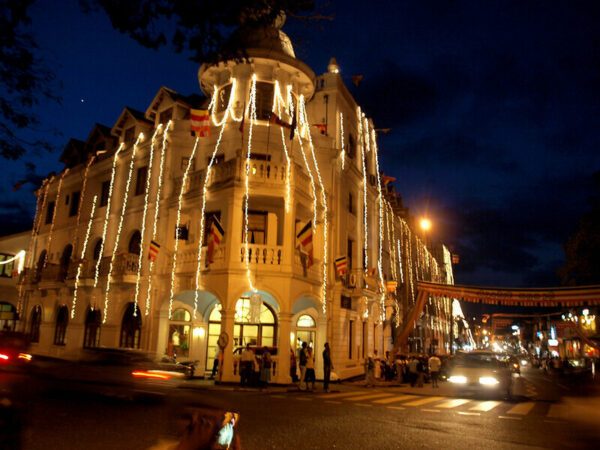
Queens hotel Kandy
Esala Perahera Entry Ticket
Attending the Kandy Esala Perahera or participating in the procession, like most festivals, is free of charge. You are welcome to step out and join the thousands of residents and devotees who move around in parades at night throughout the Kandy Perahera festival. However, if you want to watch the festivities from a balcony above, a seat will cost you roughly $60 USD, depending on the night and demand.
Image courtesy of Amila Tennakoon, Samantha McFarlane, via creative commons licenses. some rights reserved.
Kandy Perahera Festival is a Sri Lanka’s top attraction, with so many interesting activities, those who are pondering visiting Perahera festival Kandy can go through our tour packages or make the resevations through our website.
